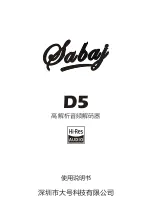
6
GLOBAL ENERGY EFFICIENCY SPECIALIST
GAQ40S3V3B
DC-DC Converter Technical Manual V1.4
Typical Waveforms
Figure 8: Output voltage ripple
(for point B in the test set-up diagram, V
in
= 48 V;
V
out
= 3.3 V; I
out
= 40 A)
Figure 7: Input reflected ripple current
(for point A in the test set-up diagram,
V
in
= 48 V;
V
out
= 3.3 V; I
out
= 40 A)
Is
Figure 5: Test
set-up
diagram
1. During the test of input reflected ripple current, the input terminal must be connected to a 12 µH inductor and a 220 µF
electrolytic capacitor.
2. Point B, which is for testing the output voltage ripple, is 25 mm (0.98 in.) away from the V
out
(+) pin.
25 mm (0.98 in.)
12 µH
DC-DC
converter
A
B
47 µF
Electrolytic
capacitor
10 µF
Tantalum
capacitor
470 µF
Tantalum
capacitor
0.1 µF
Ceramic
capacitor
V
in
(+)
V
in
(
–)
V
out
(+)
V
out
(
–)
V
source
220 µF
Electrolytic
capacitor
Figure 6: Typical circuit applications
F1: 7 A fuse (fast blowing)
C
in
: The high-frequency, low equivalent series resistance
(ESR) electrolytic capacitor (100 µF/100 V) is
recommended.
C
o1
: The 1 µF ceramic capacitor is recommended.
C
o2
: The 470 µF tantalum capacitor is recommended.
V
in
(+)
On/Off
Vi
n
(
–)
V
out
(+)
Sense(+)
Trim
Sense(
–)
V
out
(
–)
C
in
S1
F1
C
o1
C
o2
EMI
filtering
V
out
Load
Load
V
source





























